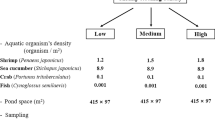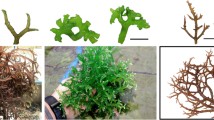Abstract
Aquaculture in saline-alkaline water has a major problem: microalgal blooming causes the pH of water to increase dramatically, thereby causing damage to the reared organisms. To solve this problem, we set out to find a candidate filter-feeding bivalve species suitable for saline-alkaline water to graze on microalgae and to control the pH. In the current study, we investigated the effect of carbonate alkalinity (CA, 2.5, 10.0, and 20.0 meq/L) and pH (8.0, 8.5, and 9.0) on the grazing capacity (GC) of the clam Cyclina sinensis. Additionally, the effect of clam size (small, medium, and large) and microalgae species (Nannochloropsis oculata, Chaetoceros müelleri, and Isochrysis galbana), and the effect of bottom sediment characteristic (mud, sandy mud, and muddy sand) and thickness (3 and 6 cm) were analyzed as well. The results show that the GC on I. galbana was the highest and small size had the maximum GC/W (W: wet weight including body and shells). No significant differences were observed between sediment type and thickness. Regarding CA and pH, a significant decrease in GC by the pH or by their interaction was found. The GC of C. sinensis was not greatly reduced in the treatments of pH≤8.5 and CA≤20.0, and also not affected by bottom sediment type, indicating that this clam is capable to manage microalgal concentrations and might be a candidate species for pH reduction in saline-alkaline water ponds.
Similar content being viewed by others
References
Allan G L, Fielder D S, Fitzsimmons K M, Applebaum S L, Raizada S. 2009. Inland saline aquaculture. In: Burnell G, Allan G eds. New Technologies in Aquaculture: Improving Production Efficiency, Quality and Environmental Management. Woodhead Publishing Limited, Woodhead. p.1119–1147.
Barkoh A, Begley D C, Smith D G, Kurten G L, Fries L L, Schlechte J W. 2011. Can solar powered circulation control Prymnesium parvum blooms and toxicity in fish hatchery ponds? Harmful Algae, 10 (2): 173–180.
Birnhack L, Shlesinger N, Lahav O. 2010. A cost effective method for improving the quality of inland desalinated brackish water destined for agricultural irrigation. Desalination, 262 (1-3): 152–160.
Cao Y B, Chen X Q, Wang S, Chen X C, Wang Y X, Chang J P, Du J Z. 2009. Growth hormone and insulin-like growth factor of naked carp (Gymnocypris przewalskii) in Lake Qinghai: expression in different water environments. General and Comparative Endocrinology, 161 (3): 400–406.
Cranford P J, Ward J E, Shumway S E. 2011. Bivalve filter feeding: variability and limits of the aquaculture biofilter. In: Shumway S E ed. Shellfish Aquaculture and the Environment. Wiley-Blackwell, Hoboken, New Jersey. p.81–124.
Dendooven L, Alcántara-Hernández R J, Valenzuela-Encinas C, Luna-Guido M, Perez-Guevara F, Marsch R. 2010. Dynamics of carbon and nitrogen in an extreme alkaline saline soil: a review. Soil Biology and Biochemistry, 42 (6): 865–877.
Fan J X, Lin Z H, **ao G Q, Chai X L, Zhao Y Q, Lu R M, Zhang J M. 2009. Effects of starvation on oxygen consumption and ammonia excretion rates of three different sizes of Meretrix meretrix Linnaeus. Marine Sciences, 33 (10): 73–76. (in Chinese with English abstract)
Gazeau F, Gattuso J P, Greaves M, Elderfield H, Peene J, Heip C H R, Middelburg J J. 2011. Effect of carbonate chemistry alteration on the early embryonic development of the Pacific oyster (Crassostrea gigas). PLoS One, 6 (8): e23010.
Gómez-Bellot M J, Álvarez S, Bañón S, Ortuño M F, Sánchez-Blanco M J. 2013. Physiological mechanisms involved in the recovery of euonymus and laurustinus subjected to saline waters. Agricultural Water Management, 128: 131–139.
Goss G G, Wood C M, Laurent P, Perry S F. 1994. Morphological responses of the rainbow trout (Oncorhynchus mykiss) gill to hyperoxia, base (NaHCO 3) and acid (HCl) infusions. Fish Physiology and Biochemistry, 12 (6): 465–477.
Guillard R R L, Ryther J H. 1962. Studies of marine planktonic diatoms: I. Cyclotella nana Hustedt, and Detonula confervacea (Cleve) Gran. Canadian Journal of Microbiology, 8 (2): 229–239.
Huang N Y, Fan Q G, Gu X L, **a L J. 2010. Diet composition of juvenile Siberian sturgeons (Acipenser baeri) cultured in inland reservoir in western China and its relations with benthic organism resources. Marine Fisheries, 32 (3): 313–319. (in Chinese with English abstract)
Huxham M, Richards M. 2003. Can postlarval bivalves select sediment type during settlement? A field test with Macoma balthica (L.) and Cerastoderma edule (L.). Journal of Experimental Marine Biology and Ecology, 288 (2): 279–293.
Jones H F E, Pilditch C A, Bryan K R, Hamilton D P. 2011. Effects of infaunal bivalve density and flow speed on clearance rates and near-bed hydrodynamics. Journal of Experimental Marine Biology and Ecology, 401 (1-2): 20–28.
Lei Y Z, Dong S L, Shen C G. 1985. Study on the toxicity of carbonate-alkaline to fishes. Journal of Fisheries of China, 9 (2): 171–183. (in Chinese with English abstract)
Leverone J R, Shumway S E, Blake N J. 2007. Comparative effects of the toxic dinoflagellate Karenia brevis on clearance rates in juveniles of four bivalve molluscs from Florida, USA. Toxicon, 49 (5): 634–645.
Li C C, Chen J C. 2008. The immune response of white shrimp Litopenaeus vannamei and its susceptibility to Vibrio alginolyticus under low and high pH stress. Fish & Shellfish Immunology, 25 (6): 701–709.
Lin T T, Lai Q F, Lu J X, Yao Z L, Wang H, Zhou K. 2012. Toxic effects of several saline-alkali factors on Cyclina sinensis. Marine Fisheries, 34 (2): 183–188. (in Chinese with English abstract)
Lin T T, Lai Q F, Yao Z L, Lu J X, Zhou K, Wang H. 2013. Combined effects of carbonate alkalinity and pH on survival, growth and haemocyte parameters of the Venus clam Cyclina sinensis. Fish & Shellfish Immunology, 35 (2): 525–531.
Lindholm T, Öhman P, Kurki-Helasmo K, Kincaid B, Meriluoto J. 1999. Toxic algae and fish mortality in a brackish-water lake in Åland, SW Finland. Hydrobiologia, 397: 109–120.
Liu W S, Ma Y H, Hu S Y, Miao G H, Li J H. 2002. Rearing Venus clam seeds, Cyclina sinensis (Gmelin), on a commercial scale. Aquaculture, 211 (1-4): 109–114.
Matthews T G, Fairweather P G. 2006. Recruitment of the infaunal bivalve Soletellina alba (Lamarck, 1818) (Bivalvia: Psammobiidae) in response to different sediment types and water depths within the intermittently open Hopkins River estuary. Journal of Experimental Marine Biology and Ecology, 334 (2): 206–218.
Minhas P S. 1996. Saline water management for irrigation in India. Agricultural Water Management, 30 (1): 1–24.
Nakamura Y, Kerciku F. 2000. Effects of filter-feeding bivalves on the distribution of water quality and nutrient cycling in a eutrophic coastal lagoon. Journal of Marine Systems, 26 (2): 209–221.
Navarro J M, Leiva G E, Martínez G, Aguilera C. 2000. Interactive effects of diet and temperature on the scope for growth of the scallop Argopecten purpuratus during reproductive conditioning. Journal of Experimental Marine Biology and Ecology, 247 (1): 67–83.
Pan L Q, Zhang L J, Liu H Y. 2007. Effects of salinity and pH on ion-transport enzyme activities, survival and growth of Litopenaeus vannamei postlarvae. Aquaculture, 273 (4): 711–720.
Quantin C, Grunberger O, Suvannang N, Bourdon E. 2008. Land management effects on biogeochemical functioning of salt-affected paddy soils. Pedosphere, 18 (2): 183–194.
Rengasamy R. 2006. World salinization with emphasis on Australia. Journal of Experimental Botany, 57(5):1017–1023.
Rozema J, Flowers T. 2008. Crops for a salinized world. Science, 322(5907):1478–1480.
Rozema J, Schat H. 2013. Salt tolerance of halophytes, research questions reviewed in the perspective of saline agriculture. Environmental and Experimental Botany, 92: 83–95.
Sharma B R, Minhas P S. 2005. Strategies for managing saline/alkali waters for sustainable agricultural production in South Asia. Agricultural Water Management, 78 (1-2): 136–151.
Thomas S, Poupin J. 1985. A study of the effects of water carbonate alkalinity on some parameters of blood acidbase status in rainbow trout (Salmo gairdneri R.). Journal of Comparative Physiology B, 156 (1): 29–34.
Truchot J P, Forgue J. 1998. Effect of water alkalinity on gill CO 2 exchange and internal Pco 2 in aquatic animals. Comparative Biochemistry and Physiology Part A: Molecular & Integrative Physiology, 119 (1): 131–136.
Truchot J P. 1984. Water carbonate alkalinity as a determinant of hemolymph acid-base balance in the shore crab, Carcinus maenas: a study at two different ambient PCO2 and PO2 levels. Journal of Comparative Physiology B, 154 (6): 601–606.
Velasco L A. 2007. Energetic physiology of the Caribbean scallops Argopecten nucleus and Nodipecten nodosus fed with different microalgal diets. Aquaculture, 270 (1-4): 299–311.
Velo A, Pérez F F, Tanhua T, Gilcoto M, Ríos A F, Key R M. 2013. Total alkalinity estimation using MLR and neural network techniques. Journal of Marine Systems, 111-112: 11–18.
Wang H, Geng L K, Fang W H, Lai Q F, Tian R Q, Zhao Z L, Wang F P, Hou J T, Yu L L, Liu Z H. 1997. Studies on the commercially experimental culture of Penaeid shrimp Peneaus chinensis, transplanted to the northwest inland salt waters. Marine Fisheries, 19 (1): 9–12. (in Chinese with English abstract)
Wang H, Lai Q F, Yao Z L, Zhou K. 2010. Healthy aquaculture in saline-alkaline lands: 100 Questions and Answers. China Agricultural Press, Bei**g. (in Chinese)
Wang H. 1996. The success of shrimp Macrobrachium rosenbergii farmed in saline-alkali water in northwest of the Yellow River regions. China Fisheries, 1): 33. (in Chinese)
Wang W N, Wang A L, Chen L, Liu Y, Sun R Y. 2002. Effects of pH on survival, phosphorus concentration, adenylate energy charge and Na+-K+ ATPase activities of Penaeus chinensis Osbeck juveniles. Aquatic Toxicology, 60 (1-2): 75–83.
Wang Z H, Song X Z, Li C L, Sun J Q, Ding J. 2015. Salinealkaline water characteristics in Cangzhou area and its control technology for shrimp culture. Hebei Fisheries, 11): 39–41. (in Chinese)
Ward J E, Cassell H K, MacDonald B A. 1992. Chemoreception in the sea scallop Placopecten magellanicus (Gmelin). I. Stimulatory effects of phytoplankton metabolites on clearance and ingestion rates. Journal of Experimental Marine Biology and Ecology, 163 (2): 235–250.
Webb J L, Vandenbor J, Pirie B, Robinson S M C, Cross S F, Jones S R M, Pearce C M. 2013. Effects of temperature, diet, and bivalve size on the ingestion of sea lice (Lepeophtheirus salmonis) larvae by various filter-feeding shellfish. Aquaculture, 406-407: 9–17.
Widdows J, Navarro J M. 2007. Influence of current speed on clearance rate, algal cell depletion in the water column and resuspension of biodeposits of cockles (Cerastoderma edule). Journal of Experimental Marine Biology and Ecology, 343 (1): 44–51.
Yao Z L, Lai Q F, Zhou K, Rizalita R E, Wang H. 2010. Developmental biology of medaka fish (Oryzias latipes) exposed to alkalinity stress. Journal of Applied Ichthyology, 26 (3): 397–402.
Zhao W, Dong S L, Shen-Tu Q C, Zhang Z Q. 2002. Studies on the species composition, biomass and species diversity of phytoplankton in saline-alkaline ponds with chloride typed. Acta Hydrobiologica Sinica, 26 (1): 31–38. (in Chinese with English abstract)
Acknowledgments
We would like to thank Professor WANG Hui (East China Sea Fisheries Research Institute, Chinese Academy of Fishery sciences) for her very comprehensive and useful information between saline-alkaline water types and dominant microalgae.
Author information
Authors and Affiliations
Corresponding author
Additional information
Supported by the Special Fund of Chinese Central Government for Basic Scientific Research Operations in Commonweal Research Institutes titled “Effect of pH on the Larva Development and Carbon Sequestration of Several Intertidal Zone Bivalves in the East China Sea (Chinese Academy of Fishery Sciences) (No. 2014A01YY02) and the Returned Central Royalties for Using Sea Areas titled “Demonstration for Ecological Restoration and Environmental Improvement in Fengxian Sea Area Located in the Northern Seacoast of Hangzhou Bay”
Rights and permissions
About this article
Cite this article
Lin, T., Zhou, K., Liu, X. et al. Effects of clam size, food type, sediment characteristic, and seawater carbonate chemistry on grazing capacity of Venus clam Cyclina sinensis (Gmelin, 1791). Chin. J. Ocean. Limnol. 35, 1239–1247 (2017). https://doi.org/10.1007/s00343-017-5334-z
Received:
Accepted:
Published:
Issue Date:
DOI: https://doi.org/10.1007/s00343-017-5334-z




